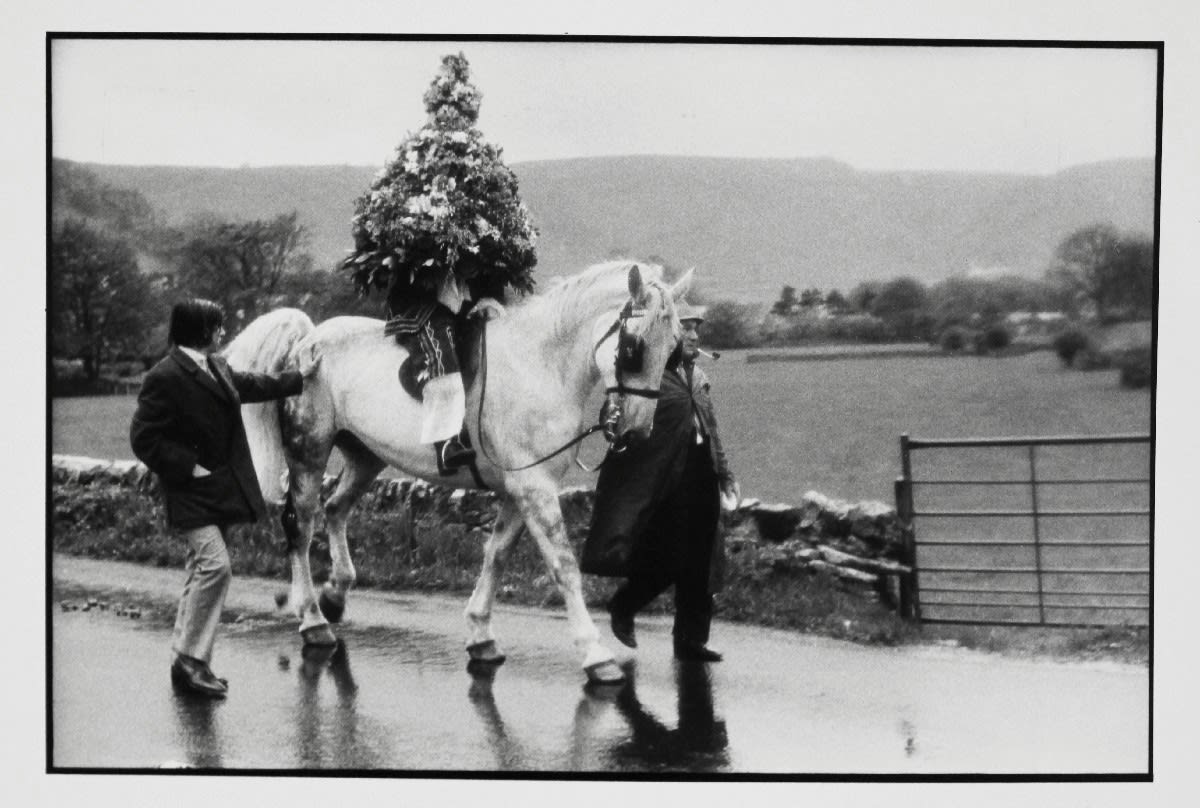Homer Sykes
The King on Horse Back. Garland Day, Castleton Derbyshire, 1972
Vintage Gelatin Silver Print
24 x 30.5 cms
9 7/16 x 12 1/16 ins
Series: Once a Year. Rare Vintage Photographs
9826
Provenance
Acquired directly from the artistExhibitions
'Radical Landscapes', Tate Liverpool, 4 May – 4-September 2022'Radical Landscapes', Mead Gallery, 19 October 2022 - 7 January 2023
Signed on the reverse. 'Garland Day', also known as 'Oak Apple Day' takes place in the village of Castleton in Derbyshire. During the day a garland of wild flowers shaped...
Signed on the reverse.
"Garland Day", also known as "Oak Apple Day" takes place in the village of Castleton in Derbyshire. During the day a garland of wild flowers shaped like a bee-hive and topped by a posy, known as the Queen is prepared. At about 6.30pm it is placed on the head and shoulders of a man wearing a Stuart costume who is led around the village on horse back. A lady in similar period costume follows riding side-saddle and a group of local school children dressed in white follow behind dancing to the village band. Adults take some refreshments at each of the six pubs whilst the band plays the "garland tune" and the children dance. The procession finishes up at the church gates where the garland is hoisted to the top of the church tower where it stays for a week tied to one of the four pinnacles. The other three are decorated with oak branches. The origins are lost in the midst of time but its genesis may be based in the Green Man fertility figure. The present ceremony dates from the Restoration of King Charles II on 29 May 1660 (this area of Derbyshire was strongly royalist in the civil war) which accounts for the Stuart costume, and the dressing of the church pinnacles with oak branches to commemorate the King's escape from the Battle of Worcester in 1651 by hiding in an oak tree.
This photograph was included in the book by Homer Sykes Once a Year: Some Traditional British Customs (Gordon Fraser, 1977)
British Photography / The Hyman Collection
"Garland Day", also known as "Oak Apple Day" takes place in the village of Castleton in Derbyshire. During the day a garland of wild flowers shaped like a bee-hive and topped by a posy, known as the Queen is prepared. At about 6.30pm it is placed on the head and shoulders of a man wearing a Stuart costume who is led around the village on horse back. A lady in similar period costume follows riding side-saddle and a group of local school children dressed in white follow behind dancing to the village band. Adults take some refreshments at each of the six pubs whilst the band plays the "garland tune" and the children dance. The procession finishes up at the church gates where the garland is hoisted to the top of the church tower where it stays for a week tied to one of the four pinnacles. The other three are decorated with oak branches. The origins are lost in the midst of time but its genesis may be based in the Green Man fertility figure. The present ceremony dates from the Restoration of King Charles II on 29 May 1660 (this area of Derbyshire was strongly royalist in the civil war) which accounts for the Stuart costume, and the dressing of the church pinnacles with oak branches to commemorate the King's escape from the Battle of Worcester in 1651 by hiding in an oak tree.
This photograph was included in the book by Homer Sykes Once a Year: Some Traditional British Customs (Gordon Fraser, 1977)
British Photography / The Hyman Collection
